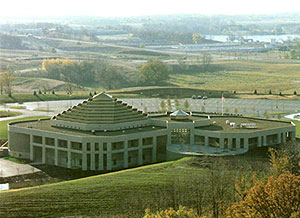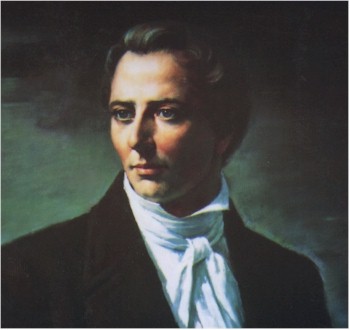 The Temple of Eck is located in Chanhassen, Minnesota. The Temple of Eck is the headquarters, so to speak, of Eckankar. The thing that first drew me to this religion is the fact that this Temple is located less than an hour from my parents house. The Temple of Eck is called the "heart of the Eckankar Spiritual Campus." It is seen by Eckists as a very comforting place where people can spiritually study their past lives, examine their dreams or explore their beliefs in soul travel. Here is the webpage where the virtual tour is. Harold Klemp is quoted, which regards to the Temple of Eck, as saying
The Temple of Eck is located in Chanhassen, Minnesota. The Temple of Eck is the headquarters, so to speak, of Eckankar. The thing that first drew me to this religion is the fact that this Temple is located less than an hour from my parents house. The Temple of Eck is called the "heart of the Eckankar Spiritual Campus." It is seen by Eckists as a very comforting place where people can spiritually study their past lives, examine their dreams or explore their beliefs in soul travel. Here is the webpage where the virtual tour is. Harold Klemp is quoted, which regards to the Temple of Eck, as sayingAny of you who visit the Temple of Eck will find it has a special character, a presence of its own. That presence is the love of God. Later, if you are ever in need of spiritual help, at bedtime imagine yourself back at the Temple. Ask the question that you need help with, and then just go to sleep. Often you'll awake in the morning with an entirely different view of the situation.This quote shows an emphasis on dreaming that is present throughout all of Eckankar. The Eck Masters speak to people in their dreams, and here Harold Klemp is encouraging people to come to the temple, reflect on their spiritual concerns and the Temple as well as the Eck Masters will help them. The Temple of Eck is used for a spiritual purpose, but it is not just for Eckists. The Temple is open for all religions, and even for people who do not have a religion at all. They believe that all can benefit from visiting the Temple.
The Temple of Eck has hours listed on their website as well. Something interesting is that the Temple is not open during any religiously celebrated holidays. This shows that they really are not aligning themselves with any other religion. They also have tours available during the week and the weekends for any person to take.
 |
| View of a sign at the beginning of the Contemplation Trails |
 Though the temple is located in a suburb of Minneapolis, they put an emphasis on making this Temple a picturesque space. It is located on over 100 acres of woods and prairies, and they also have seasonally open Contemplation trails that, combined, are over two miles long. These Contemplation Trails were made for people to walk on and reflect on all of the wonderful things in their lives. They are meant as a place for people to contemplate all of the reasons they have to be grateful. On the left is a map of the Contemplation Trails. There are signs located throughout the trails, and on those signs there are some writings of Harold Klemp that explain many Eckist beliefs as well as writings meant to inspire one to contemplate one's life, the spirit and God. These trails show that there is an emphasis on the balance one achieves through contemplation in nature. Though these trails are mainly covered in snow for 7 months a year, they are still very important in the Eckankar faith.
Though the temple is located in a suburb of Minneapolis, they put an emphasis on making this Temple a picturesque space. It is located on over 100 acres of woods and prairies, and they also have seasonally open Contemplation trails that, combined, are over two miles long. These Contemplation Trails were made for people to walk on and reflect on all of the wonderful things in their lives. They are meant as a place for people to contemplate all of the reasons they have to be grateful. On the left is a map of the Contemplation Trails. There are signs located throughout the trails, and on those signs there are some writings of Harold Klemp that explain many Eckist beliefs as well as writings meant to inspire one to contemplate one's life, the spirit and God. These trails show that there is an emphasis on the balance one achieves through contemplation in nature. Though these trails are mainly covered in snow for 7 months a year, they are still very important in the Eckankar faith. Now, let's start the virtual tour! You are encouraged to take the tour yourself, it was linked above. But there are screen shots from the virtual tour of the Temple of Eck.
 | ||||||||||||||||
| This is the entrance into the Temple of Eck. |
 |
| Stage in front of the Chairs in Sanctuary |
 |
| Blue Star on ceiling of the Sanctuary |
The sanctuary actually looks more like a very nice recital hall more than a sanctuary. The seats in the sanctuary are just like seats you would find in a movie theater or recital hall, they are individual and even have arm rests. You can see on the left here, that this looks more like a concert hall than anything else. It is very beautiful, but there is almost nothing that would indicate it is a place for religious gathering. There are no holders for bibles or hymn books behind the seats. The system of symbols the Eckists follow are based more in the spiritual world and deal more with terms and ideas instead of tangible objects, so it makes sense that the sanctuary would not have explicit symbols scattered throughout it.
 | ||
| Eck Masters on the front wall of the Chapel |
The fellowship hall is where receptions take place, as well as other group gatherings. It is a very large hall, and again is characterized by the distinct lighting, the beige color scheme. The front of the fellowship hall, has some symbols, but still very little. The EK logo is front and center, and a picture depicting a white bird is displayed to the
left of it.
From what I have seen of the Temple of Eck, is that it is very beautiful. It's simplistic and none of the rooms are rectangular. There rooms are always more rhombus or circular shaped. I couldn't help but notice the ceiling of the fellowship hall. To me, it seemed to be inspired by more mission style architecture. Frank Lloyd Wright designed many houses in a mission style, and the ceiling reminds me of that. He designed many mission style stained glass windows, and though there are no stained glass windows in this temple, this ceiling seems inspired by those mission style windows. This is interesting, because the work of Frank Lloyd Wright has very strong ties to the Midwest. So many of his houses are in Wisconsin, Minnesota and Illinois. Look at the stained glass window below, it looks a lot like the blue six-pointed star on the ceiling of the sanctuary, and it is also similar to the ceiling of the fellowship hall. Also, just the angles of the walls and the orientations of the rooms in the temple remind me of this stained glass window. It would make sense for a religion that is based out of the Midwest would have a temple whose architecture is inspired by the work of such a Midwesternly based architect.
 |
| Frank Lloyd Wright Designed Stained Glass |


























